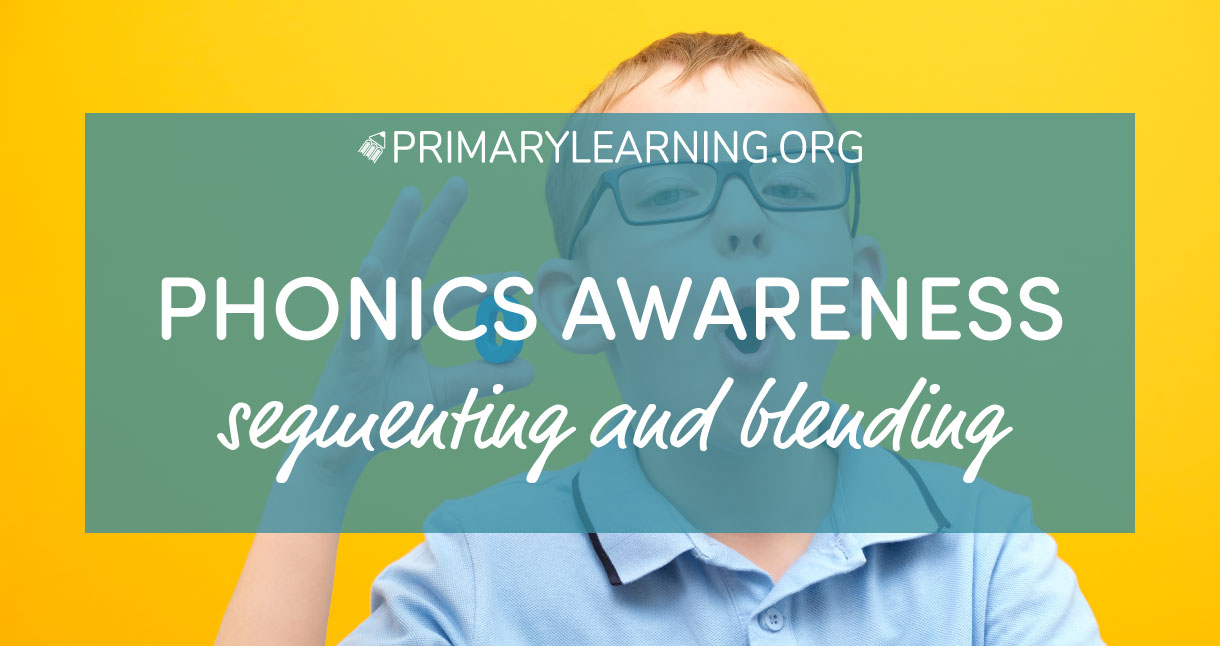

Posted by: Alesia Netuk
Updated: October 2nd, 2023
Phonemic Awareness: Blending and Segmenting
Phonemic Awareness: Blending and Segmenting
Blending and segmenting are essential skills to teach young readers. The ability to blend sounds together and break sounds apart supports both reading and writing development.
What is Blending and Segmenting?
When teaching children how to blend sounds, it is important that they learn to do so fluidly, moving from one sound right into the next. For example, they need to be careful not to add short ‘u’ sounds when blending the sounds in “dog,” so it sounds like ‘du-o-gu.’ When beginning readers do this, it can make sounding out words difficult.
Blending Words Examples:
Blending is the process of combining sounds to make words. For example, the word “dog” is made up of three sounds: ‘d-o-g.’ A more complex example is a word like “black,” which has five letters but is made up of three sounds: ‘bl-a-ck.’ As you can see from these two examples, blending words involves joining individual sounds together to make words, and also requires readers to blend letters together within words to make sounds.
Segmenting Words Examples:
Segmenting is the opposite of blending. It is the process of breaking the sounds apart in words, whereas blending focuses on putting the sounds back together. For example, you can segment the word “bat” into three parts: ‘b-a-t.” The word “shut” can also be broken into three parts, because the ‘s’ and ‘h’ form one sound together: ‘sh-u-t.’
Why Teach Blending and Segmenting?
Blending and segmenting are key components of phonological awareness. As children are learning the sounds that letters make, being able to combine those sounds allows them to decode unfamiliar words while reading. Proficient readers have knowledge not only of individual sounds but also of how letters blend together to make one sound. Consider the word “thin.” Knowing that ‘t’ and ‘h’ blend to make one sound is key to decoding the word.
When children use segmenting while reading, they look for parts they know in words. For example, to decode the word “sitting,” proficient readers see ‘ing’ as one sound. If they attempted to sound out ‘ing’ by its individual letters, they would have difficulty solving the word.
Segmenting also comes into play frequently when children are writing. Breaking a word into parts helps them spell the word. Consonant-vowel-consonant, or CVC words, can be the easiest to break into parts. Beginning writers can say a word like “hat” slowly, and write the three sounds they hear: ‘h-a-t.’ When they tackle a longer word, like “stop,” we want them to hear ‘st-o-p.’
How to Teach Blending Sounds
The first step in learning how to blend is developing knowledge of the sounds letters make. Children do not need to know every sound before they start joining them together, but should be well on their way to developing a solid foundation of letter-sound correspondence.
Sounds can be taught by pairing each letter with a familiar picture or object that begins with that sound. For example, use a picture of a snake to help children remember the sound that ‘s’ makes. You can also use words of personal significance to help teach sounds. Children may recall the sound the first letter of their name makes, that “dad” starts with ‘d,’ or that their best friend’s name starts with ‘T.”
Introduce segmenting and blending with CVC cards:
The AB Family Words – Segmentation Cards
The AB family words segmenting and blending cards allow students to isolate individual sounds within words and blend them together.
The AD Family Words – Segmentation Cards
The AD family words segmenting and blending cards allow students to isolate individual sounds within words and blend them together.
The AG Family Words – Segmentation Cards
The AG family words segmenting and blending cards allow students to isolate individual sounds within words and blend them together.
The AM Family Words – Segmentation Cards
The AM family words segmenting and blending cards allow students to isolate individual sounds within words and blend them together.
The AN Family Words – Segmentation Cards
The AN family words segmenting and blending cards allow students to isolate individual sounds within words and blend them together.
The AP Family Words – Segmentation Cards
The AP family words segmenting and blending cards allow students to isolate individual sounds within words and blend them together.
The ED Family Words – Segmentation Cards
The ED family words segmenting and blending cards allow students to isolate individual sounds within words and blend them together.
The EN Family Words – Segmentation Cards
The EN family words segmenting and blending cards allow students to isolate individual sounds within words and blend them together.
The ET Family Words – Segmentation Cards
The ET family words segmenting and blending cards allow students to isolate individual sounds within words and blend them together.
The ID Family Words – Segmentation Cards
The ID family words segmenting and blending cards allow students to isolate individual sounds within words and blend them together.
The IG Family Words – Segmentation Cards
The IG family words segmenting and blending cards allow students to isolate individual sounds within words and blend them together.
The IP Family Words – Segmentation Cards
The IP family words segmenting and blending cards allow students to isolate individual sounds within words and blend them together.
The IT Family Words – Segmentation Cards
The IT family words segmenting and blending cards allow students to isolate individual sounds within words and blend them together.
The OT Family Words – Segmentation Cards
The OT family words segmenting and blending cards allow students to isolate individual sounds within words and blend them together.
The UB Family Words – Segmentation Cards
The UB family words segmenting and blending cards allow students to isolate individual sounds within words and blend them together.
The UG Family Words – Segmentation Cards
The UG family words segmenting and blending cards allow students to isolate individual sounds within words and blend them together.
The UM Family Words – Segmentation Cards
The UM family words segmenting and blending cards allow students to isolate individual sounds within words and blend them together.
The UN Family Words – Segmentation Cards
The UN family words segmenting and blending cards allow students to isolate individual sounds within words and blend them together.
The UT Family Words – Segmentation Cards
The UT family words segmenting and blending cards allow students to isolate individual sounds within words and blend them together.
Letter sounds can also be discussed as children sort magnetic letters, put together letter puzzles, listen to alphabet books, and work on alphabet printables.
As they acquire knowledge of letter sounds, children can begin learning how to blend sounds before they start reading. Blending can be done orally, without the need for print. Oral blending is helpful to start with short words that have very clear sounds. CVC words lend themselves well to learning how to blend. Use a word like “cat” or “cup” and model how to say it slowly. Exaggerate the three sounds so children can hear them. Provide them with practice saying words slowly themselves. Again, choose words with very distinct sounds to promote success.
Sound boxes, also known as “elkonin boxes,” can be used to support blending. To use sound boxes, children slide a chip or counter up into a square for each sound they hear as they say a word slowly. For example, a sound box for the word “sun” can show a picture of the sun. The word “sun” does not need to be shown for this activity and the picture will suffice. Under the picture, draw three boxes, one for each sound: ‘s-u’n.’ As children say “sun” slowly, they slide a chip into each box, moving from left to right.
As children become proficient with the use of sound boxes, they can try more complex words, including those with letters that combine to make one sound. (e.g., ‘ch’)
Children may require direct teaching of blends like ‘sp’ and ‘bl.’ Model how to combine the two letters to make one fluid sound. As they begin reading, it’s important to have them practice blending as they encounter unfamiliar words in books. Take advantage of teachable moments when they decode new words.
Blending Interventions
If children are struggling with blending, try to pinpoint what their challenges are stemming from. Perhaps they need more time to learn the sounds individual letters make. Also, determine if there are speech issues that make saying the sounds challenging. Struggling readers also need to be able to hear sounds correctly in order to reproduce them. A speech and language pathologist may be able to help identify potential challenges. As well, it’s important to know if children have picked up habits like guessing, not looking at the whole word, or not looking left to right. Once you have identified the problem, you can intervene with more teaching and modeling, or enlist the support of an outside professional. Early intervention is key so children can get off to a great start as they learn to read.
LEARNING MATERIALS TO MEET EVERY CHILD’S NEEDS
Here, at PrimaryLearning.Org, we tend to deliver the best-differentiated learning materials to K-2 students. Our resources can be easily incorporated into multisensory lessons to meet every child’s needs, whether s/he is a visual, kinesthetic, or auditory learner.